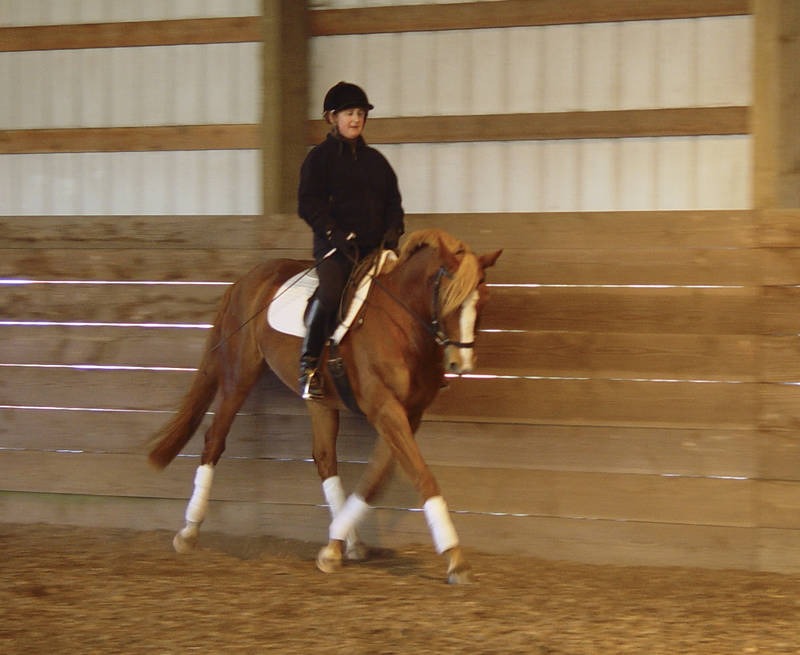An Introduction to Centered Riding
By Alys Culhane

One day as I was instructing a student I noted that her jaw was clenched, she had a death grip on the reins, and her legs were wrapped tightly around her horse’s middle. The young gelding appeared ready to explode. I told her to breathe. The lesson continued without incident, but I was bothered by the fact that I was unable to provide her with more breathing-related specifics.
My realization prompted me to become a Centered Riding instructor. I learned from Susan Harris, a Level 4 instructor who worked directly with Sally Swift, the founder of Centered Riding. Harris explained that Swift used the term Centered Riding in describing these six basics: Centering, Soft Eyes, Breathing, Alignment, Grounding, and Clear Intent. Harris also verified that becoming body-aware encourages greater horse/rider connectivity.
Through coursework in both anatomy and physiology I was able to put Swift’s theories into practice by having a more complete understanding of our muscular, skeletal, and special senses systems, as well as the circulatory, respiratory, and cardiac systems. I have since made the following connections between Sally Swift’s six basics and anatomical principles.
Soft Eyes
Using peripheral vision enables us to relax our skeletal muscles and to tell our horse that “at this very minute we are okay.” We humans have over 500 facial muscles, most of which are relaxed when we use our soft eyes. Drawing attention to each of these muscles is an impossibility. I suggest first bringing your awareness to your face, and then to the muscles surrounding your eyes. Snort like a horse, twitch your nose like a rabbit, puff your cheeks out like a chipmunk, and drop your jaw open like a tired chimpanzee. You can easily come up with other images. In fact, the odder they are, the more likely you are to bring awareness to specific muscle groups.
Breathing
Here’s a too familiar scenario. The horse hears snow fall off the arena roof and bolts. “Breathe!” the instructor yells. Rather than relax, the rider inhales and holds her breath. This sort of directive is meant to calm the horse. However, the opposite can occur when the instructor utters a terse, one-word command.
Picture your lungs like two sacks, and your diaphragm as a cup-shaped, stretchy muscle. Picture that stretchy muscle pulling and pushing air into and out of the lungs. Regulate your breath and your horse will respond accordingly.
Alignment
Swift used the image of building blocks to describe balance. Your head and neck are your first building block, the ribcage and shoulder your second, your pelvis your third, and your legs and feet your fourth building block. The correct lineup of the blocks (viewing the body sideways) will allow you to drop a plumb line from the ear through the tip of the shoulder, hip joint, and ankle.
Centering
Becoming centered is an interconnected endeavor. Swift notes that you find your center by pointing a finger at your belly to a spot between your navel and pubic arch, the front of your pelvis. Deep behind that point, against the front of your spine, like your center of balance, is your center of energy, and your center of control. Consequently, you become centered when you bring your awareness to this area, and to your soft eyes and diaphragm.
Grounding and Clear Intent
Swift added grounding and clear intent to her original list of basics. The two are more abstract than the above four because they don’t have anatomical points of reference. Swift defines grounding as a sensation of connection with the ground that offers the rider increased stability. You feel as though your well-established center is dropping energy down through your legs and feet into the ground, as the energy in the ground comes up to your feet. Clear intent is “a precise positive understanding, a picture of what you want.” You become grounded when you’re fully centered, and you’re able to convey your intentions to your horse when you’re grounded.
In upcoming articles, I will elaborate on Sally Swift’s Centered Riding basics and suggest ways in which you as a rider might put them to use.

Alys Culhane is a writer and Centered Riding instructor. She and her husband Pete live in Palmer, Alaska. They share their off-the-grid place with three Icelandic horses, two dogs, two chickens, and three goats. Alys has published articles in numerous outdoor magazines and horse journals. She’s the author of Raudi’s Story: An Icelandic Mare’s first four years of life. Alys and Pete have done two lengthy, unsupported long treks on their Icelandic horses, and hope in the future to do more rides. She writes daily dispatches which she posts on her website, www.alysculhane.com.

